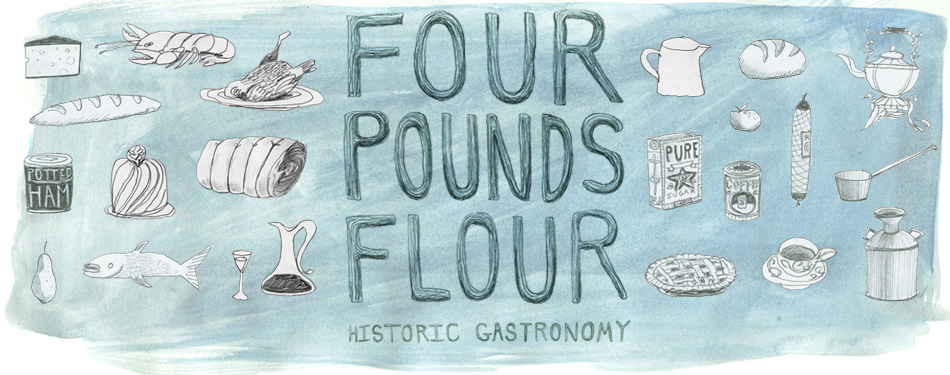
(illustration: Jerry Thomas’ How to Mix Drinks)
I recently read an 1873 article on the celebration of New Year’s Day in New York. Punch was a major player in the day’s celebrations. So popular was the drink, that Professional Punch-Makers traveled house to house, mixing the brew:
“Punch is seen in all its glory on this day, and each household strives to have the best of this article. There are regular punch-makers in the city, who reap a harvest at this time. Their services are engaged long before-hand, and they are kept busy all morning going from house to house, to make this beverage, which is no-where so palatable as in this city.”
During the course of the day, ladies staid home to receive guests, and gentleman went from house to house visiting friends and, apparently, sampling the punch:
“Towards the close of the day, everything is in confusion–the door-bell is never silent. Crowds of young men, in various stages of intoxication, rush into the lighted parlors, leer at the hostess in a vain effort to offer their respects, call for liquor, drink it, and stagger out, to repeat the same scene at some other house…Strange as it may seem, it is no disgrace to get drunk on New Year’s Day. The next day one half of New York has a headache…”
Punch was so important to Victorian Americans that it occupies the first chapter of Jerry Thomas’ How to Mix Drinks, the first bartending guide ever published. He offers these pieces of advice on the preparation of punch:
“To make punch of any sort of perfection, the ambrosial essence of lemon must be extracted by rubbing lumps of sugar on the rind, which breaks the delicate little vessels that contain the essence, and at the same time absorb it. This, and making the mixture sweet and strong, using tea instead of water, and thoroughly amalgamating all the compounds….is the grand secret, only to be acquired by practice.”
Here are a few of Thomas’ recipes; he has 86 in his book, so if you don’t like these, feel free to choose some of your own. If you choose to add some punch to your New Year’s celebration, please send me some photos and notes. I’m especially interested in seeing the sugar-rubbed-lemon technique and punches made with tea vs. water.
All notes in parenthesis are my own.
Hot Brandy and Rum Punch
For a party of 15.
1 quart of Jamaica Rum
1 quart Cognac Brandy
1 lb. of white loaf-sugar (regular white granulated sugar should be used here)
4 lemons
3 quarts boiling water
1 teaspoonful of nutmeg (freshly grated)
Rub the sugar over the lemons until it had absorbed all the yellow part of the skins, then put the sugar into a punch-bowl; add the ingredients well together, pour over them the boiling water, stir well together; add the rum, brandy and nutmeg; mix thoroughly, and the punch will be ready to serve.
1/2 wine-glass of Irish whiskey (1/2 wine glass = 2 oz.)
1/2 wine-glass Scotch whiskey
1 tea-spoonful of sugar
1 piece of lemon
2 wine-glasses hot water
This is a capital punch for a cold night.
Pine-Apple Punch
For a party of ten.
4 bottles of champagne
1 pint Jamaica Rum
1 pint brandy
1 gill of Curacao (5 ounces)
Juice of 4 lemons
4 pine-apples sliced (I think pineapples would be smaller. 2-3 should do you.)
Sweeten to taste with pulverized white sugar (confectioner’s sugar)
Put the pine-apple with one pound of sugar in a glass bowl, and let them stand until the sugar is well soaked in the pine-apple, then add all other ingredients, except the champagne. Let this mixture stand in ice for about an hour, then add the champagne. Place a large block of ice in the center of the bowl, and ornament it with loaf sugar, sliced orange, and other fruits of the season.
Egg Nogg
Use a large bar glass.
1 table-spoonful of fine sugar, dissolved with
1 table-spoonful cold water and
1 egg.
1 wine-glass of Cognac brandy
1/2 wine-glass Santa Cruz rum
1/3 tumblerful of milk
Fill the tumbler 1/4 full with shaved ice, shake the ingredients until they are thoroughly mixed together, and grate a little nutmeg on top. Hot Egg Nogg…is very popular in California, and is made in precisely the same manner as the cold egg nogg…except that you must use boiling water instead of ice.
Regent’s Punch
For a party of twenty.
The ingredients for this renowed (sic) punch are: —
3 bottles champagne
1 bottle Hockheimer ((sic) this could be replaced with another Riesling)
1 bottle Curacoa (sic)
1 bottle Cognac
1 bottle Jamaica Rum
2 bottles Madeira
2 bottles Seltzer
4 lbs bloom raisins (I have no idea what a “bloom” raisin is compared to a regular raisin)
To which add oranges, lemons, rock candy, and instead of water, green tea to taste. Refrigerate with all the icy power of the Arctic.
Further reading: Dip Into the Past: Rediscovering The Pleasures Of Punch (New York Times)


